Pesticide usage in Scotland: arable crops and potato stores 2016
This publication presents information from a survey of pesticide use on arable crops and potato stores in Scotland during 2016.
This document is part of a collection
General trends
Crop area
The estimated area of arable crops grown in 2016 was 494,167 hectares (Table 40). This represents a seven per cent decrease from 2014 (3) to 2016 and a six per cent decrease from 2012 (4) to 2016. Since the last survey, areas of spring oats, combine peas and field beans increased (36, 26 and 9 per cent respectively); while winter oilseed rape, spring barley, winter barley and seed potatoes have decreased (17, 13, 9 and 4 per cent respectively; Table 44, Figures 1 and 2).
In 2016, spring barley accounted for 49 per cent of the arable crop area, wheat 22 per cent, winter barley ten per cent, winter oilseed rape six per cent and spring oats five per cent. The remainder is comprised of potatoes, winter oats and legumes ( Figure 3). The largest area of arable crops was in the Aberdeen region, followed by Angus, the Tweed Valley and the Central Lowlands ( Figure 4).
Figure 1 Area of cereal crops grown in Scotland 2012-2016
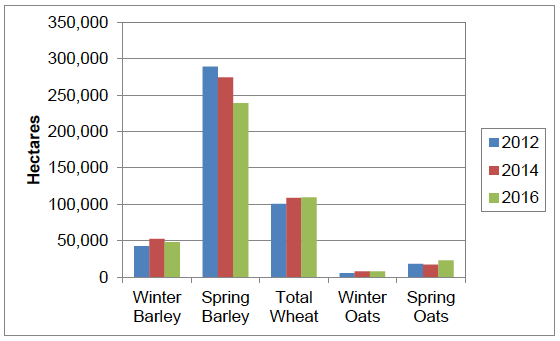
Figure 2 Area of winter oilseed rape, potatoes and legumes grown in Scotland 2012-2016
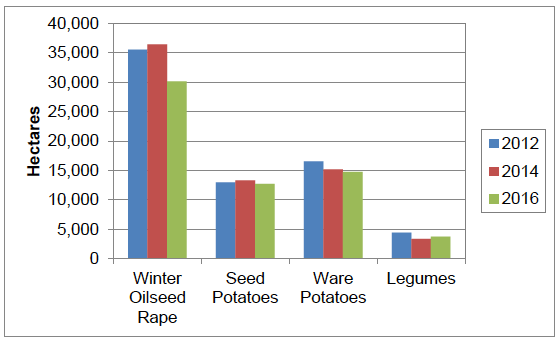
Note: legumes include field beans and combine peas
Figure 3 Arable crop areas 2016 (percentage of total area)
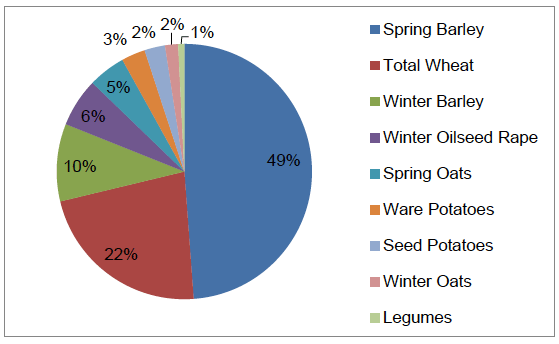
Figure 4 Regional distribution of arable crops in Scotland 2016
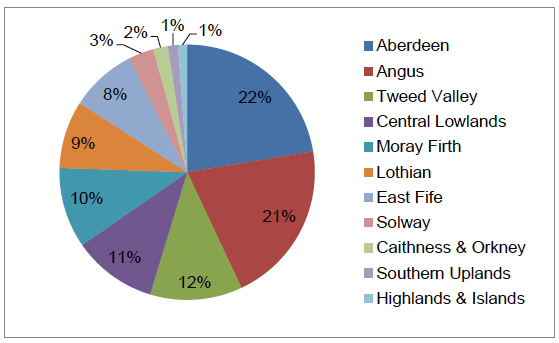
Pesticide usage
The majority of arable crops (98 per cent) received a pesticide treatment in 2016. Seed potatoes, winter oilseed rape, winter wheat, winter barley, spring barley and ware potatoes had the highest overall proportion of crop treated with pesticides (> 98 per cent, Figures 11 & 12, Table 1). Winter oats, spring wheat, legumes and spring oats had lower proportions of treated crop area (94, 93, 89 and 87 per cent respectively). In terms of the number of applications of pesticides, the treated area of arable crops received on average 4.2 sprays (excluding seed treatments). It should be noted this only applies to the treated proportion of the crop (97 per cent). Ware potatoes received the highest number of applications with an average of 13.5 sprays. In contrast, spring wheat received 2.1 sprays on average (Table 1).
It is estimated that the area of arable crops treated with a pesticide formulation in 2016 was ca. 4,851,771 hectares compared with ca. 5,247,614 hectares in 2014 and ca. 5,085,653 hectares in 2012 (Table 40). This represents a decrease of eight per cent since 2014 and five per cent since 2012. In terms of weight of pesticide applied, 1,490 tonnes was applied in 2016, representing a decrease of one per cent from 2014 and an increase of four per cent from 2012 (Table 40).
In order to make accurate comparisons between the 2016 data and the data collected in previous surveys, it is important to take into account the differences in crop area between the years. Therefore, the number of treated hectares per hectare of crop grown and the total weight of pesticide used per hectare of crop grown were calculated. Once crop area is taken into account, there is little difference in area of total pesticides applied between the surveys. There was no change from 2014 to 2016 and an increase of two per cent from 2012 to 2016 in terms of the total pesticide treated area per area of crop grown ( Figure 7). In terms of quantity of pesticides used per hectare of crop grown, there was an increase of six per cent from 2014 to 2016 and an increase of 11 per cent from 2012 to 2016 ( Figure 10).
Fungicides were the most frequently used pesticides on arable crops, followed by herbicides ( Figure 6). This pattern was also observed in 2014 and 2012. In 2016, fungicides accounted for 46 per cent of the total pesticide treated area and 44 per cent of the total weight of active substances applied ( Figures 5 & 8). When changes in crop area are taken into account, there was a one per cent decrease in area treated with fungicides from 2014 to 2016 and no difference in area treated from 2012 to 2016 ( Figure 7). The weight of fungicides applied per hectare increased by eight per cent from 2014 to 2016 and by 16 per cent from 2012 to 2016 ( Figure 10). The increase in weight applied, may partly be due to the increased use of chlorothalonil, which is applied at high dose rates.
In 2016, herbicides (including desiccants) accounted for 29 per cent of the total pesticide treated area and 36 per cent of the total weight of active substances applied ( Figures 5 & 8). When changes in crop area are taken into account, there was a five per cent increase in the area treated with herbicides from 2014 to 2016 and from 2012 to 2016 and a four per cent increase in quantity of herbicides applied ( Figures 7 & 10).
Insecticides accounted for ten per cent of the total pesticide treated area and one per cent of the total weight of active substances applied ( Figures 5 & 8). In 2016, pyrethroids accounted for 86 per cent of the area treated with an insecticide (Table 34). When changes in crop area are taken into account, there was a 27 per cent decrease in area treated from 2014 to 2016 and a seven per cent decrease from 2012 to 2016 ( Figure 7). The quantity of insecticides applied per hectare of crop grown was found to have decreased by 54 per cent from 2014 to 2016 and by 48 per cent from 2012 to 2016 ( Figure 10). The previous survey in 2014 was a high pressure year with weather conditions leading to problems with aphid and leatherjacket populations and increased insecticide use (3). . The withdrawal of the active substance chloropyrifos, used as a treatment for leatherjackets and wheat bulb fly on cereals may also have had an impact on the use of insecticides. The use of chloropyrifos has declined by 93 per cent since the previous survey. As chloropyrifos was applied at high rates, there are larger decreases in weight of insecticides applied than area.
Molluscicides accounted for nine per cent of the total pesticide treated area and one per cent of the total weight of active substances applied ( Figures 5 & 8). When changes in crop area are taken into account, there was a 36 per cent increase in area treated from 2014 to 2016 and a 24 per cent decrease from 2012 to 2016 ( Figure 7). The quantity of mollusicides applied per hectare of crop grown was found to have increased by 58 per cent from 2014 to 2016 but decreased by 18 per cent from 2012 to 2016 ( Figure 10). The mild winter weather allowed slugs to survive into the spring of 2016, which may have resulted in an increase in the use of molluscicides (5) from the previous survey.
Growth regulators accounted for four per cent of the total pesticide treated area and 14 per cent of the total weight of active substances applied ( Figures 5 & 8). When changes in crop area are taken into account, there was little change in area treated from 2014 to 2016 and an increase of 19 per cent from 2012 to 2016 ( Figure 7). The quantity of growth regulators applied per hectare of crop grown increased by nine per cent from 2014 to 2016 and by 24 per cent from 2012 to 2016 ( Figure 10).
Seed treatments accounted for two per cent of the total pesticide treated area and two per cent of the total weight of active substances applied ( Figures 5 & 8). When changes in crop area are taken into account, there was a two per cent decrease in area treated between 2014 and 2016 and a four per cent decrease between 2012 and 2016 ( Figure 7). The weight of seed treatments applied per hectare has increased by one per cent from 2014 and decreased by ten per cent since 2012 ( Figure 10).
Sulphur accounted for less than one per cent of the total pesticide treated area and two per cent of the total weight of active substances applied ( Figures 5 & 8). When changes in crop area are taken into account, there was a 12 per cent increase in area treated from 2014 to 2016 and a 78 per cent increase from 2012 to 2016 ( Figure 7). The quantity of sulphur applied per hectare of crop grown increased by 66 per cent from 2014 to 2016 and 89 per cent from 2012 to 2016 ( Figure 10). It should be noted some of the sulphur use may be for crop nutrition purposes. However, the increase may also have been influenced by use of sulphur as a fungicide on organic crops encountered in this survey.
Three active substances were recorded for the first time in the 2016 arable survey. These included the herbicide halauxifen-methyl, a new active substance developed for targeting broad-leaved weeds in cereal crops and the herbicides metobromuron and pyraflufen-ethyl (Table 39).
Whilst the overall use of pesticides in 2016 has shown minor changes from the previous survey, there has been major variation in the use of some individual active substances. For example, there were substantial increases in the use of the growth regulator chlormequat chloride (457 per cent by weight applied) on winter wheat, winter barley and spring barley since the previous survey (Table 38). Use of the molluscicide metaldehyde has increased by 96 per cent by area treated and 112 per cent by weight applied (Tables 37 & 38). This could be partly due to changes in authorisation for molluscicides. All products containing methiocarb were withdrawn from use on 19 th September 2015, therefore the use of metaldehyde and ferric phosphate increased. The use of the seed treatment imazalil has increased by 110 per cent by area treated. The use of the herbicide picolinafen increased by 90 per cent by area treated, whilst the herbicide chlorotoluron decreased by 93 per cent by weight applied.
For the first time in this series of reports, insecticides, fungicides and herbicides have been classified into groups according to their mode of action (Tables 34-36).
Winter oilseed rape insecticide use
In December 2013, the European Commission amended the approval conditions for three neonicotinoid insecticides; clothianidin, imidacloprid and thiamethoxam due to concern that there was insufficient information to fully describe their risk to pollinators. In the UK, the main impact of these restrictions was the loss of insecticidal seed treatments for oilseed rape. In the absence of seed treatments, growers are reliant on foliar insecticides for insect control in the autumn crop establishment period. As the restrictions were imposed after the 2014 oilseed rape crops were drilled, 2016 is the first in this series of surveys to reflect crops grown without insecticidal seed treatments.
Overall insecticide use on winter oilseed rape was 9 per cent lower in this survey than in 2014 (43,782 ha and 805 kg in 2016 and 47,987 ha and 886 kg in 2014). However, there was a 17 per cent decrease in the area of winter oilseed rape grown between the two surveys (36,420 and 30,141 ha in 2014 and 2016 respectively). This decrease in crop area was influenced by late harvest in 2015 coupled with adverse weather conditions which made autumn drilling conditions difficult (6)(7). Taking crop area into account, there was a 10 per cent increase (in relation to both spray area and weight) in foliar insecticides applications to winter oilseed rape crops in 2016 in comparison with 2014. A more detailed analysis of the effect of the loss neonicotinoid seed treatments on Scottish crops can be found in the reports of two earlier surveys which focussed on the impact of the first two years of the restrictions on Scottish winter oilseed rape cultivation (7)(8).
Figure 5 Use of pesticide on arable crops (percentage of total area treated with formulations) - 2016
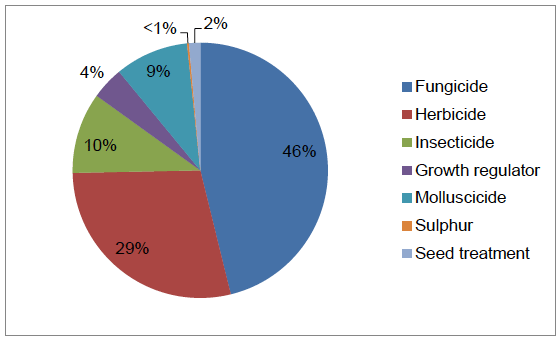
Note: insecticide includes nematicides
Figure 6 Area of arable crops treated with major pesticide groups in Scotland 2012-2016
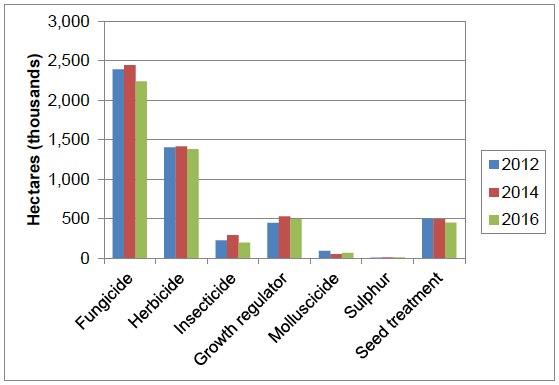
Note: insecticide includes nematicides
Figure 7 Number of pesticide treated hectares (formulations) per hectare of crop grown in Scotland 2012-2016
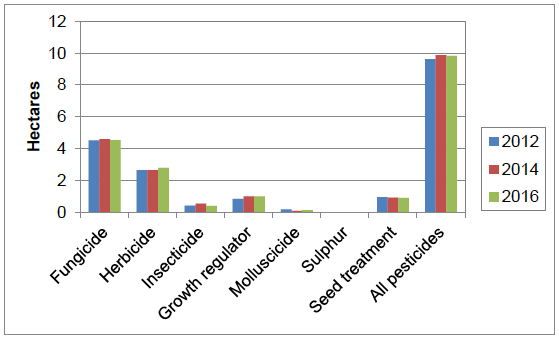
Note: insecticide includes nematicides
Figure 8 Use of pesticides on arable crops (percentage of total quantity of active substances applied) - 2016
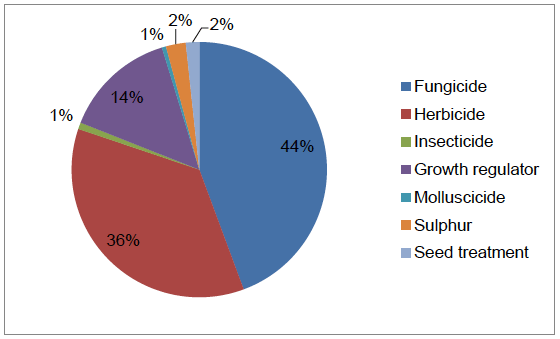
Note: insecticide includes nematicides
Figure 9 Quantity of the major pesticide groups applied to arable crops in Scotland 2012-2016
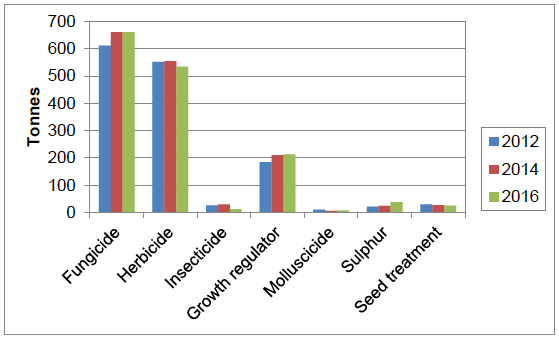
Note: insecticide includes nematicides
Figure 10 Weight of pesticide (kg) applied per hectare of crop grown in Scotland 2012-2016
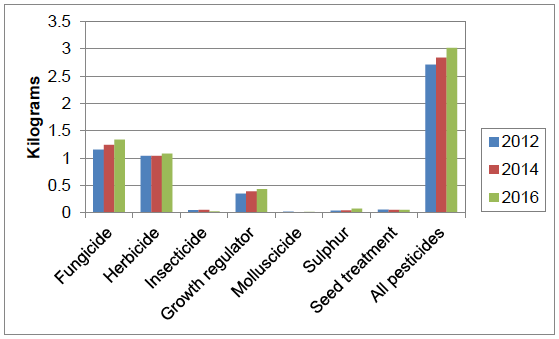
Note: insecticide includes nematicides
Figure 11 Percentage of cereal crops treated with pesticides 2016
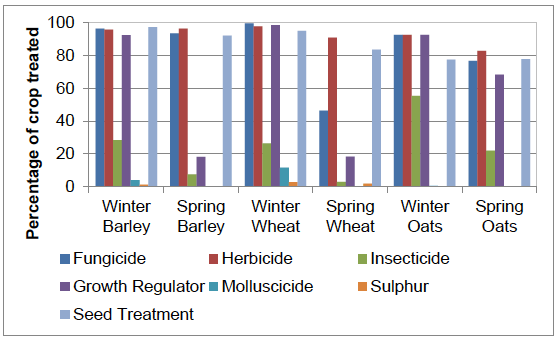
Figure 12 Percentage of winter oilseed rape, potatoes and legumes treated with pesticides 2016
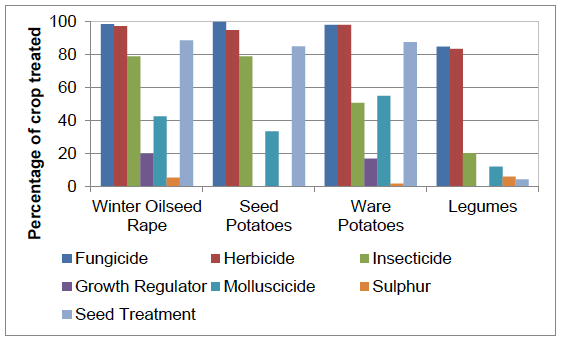
Note: legumes includes dry harvest peas and field beans. Insecticide includes nematicides
Figure 13 Average number of pesticide applications on treated area of cereal crops
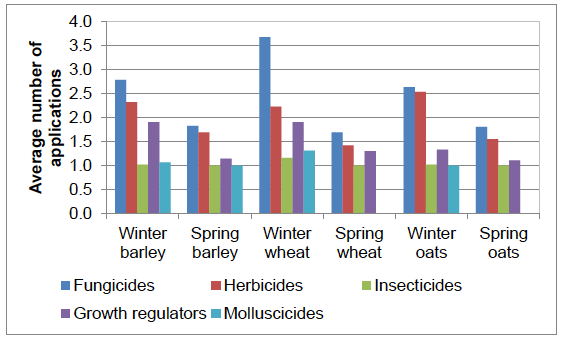
Note: See Table 1 for percentage of crop treated
Figure 14 Average number of pesticide applications on treated area of winter oilseed rape, potato and legume crops
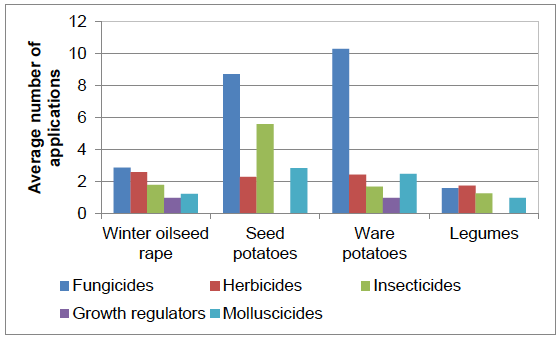
Note: See Table 1 for percentage of crop treated. Insecticide includes nematicides
Integrated pest management
For the first time in this series of surveys, additional data collection was conducted in relation to grower adoption of Integrated Pest Management ( IPM) measures. This is a summary of the data; please refer to Appendix 6 for the full dataset. Growers were asked a series of questions about the IPM activities that they implemented for their arable crop production. Unlike the other statistics in this report, the figures relating to IPM are not raised (i.e. are not national estimates) but represent only the responses of those surveyed.
In total IPM data was collected from 113 farmers, representing 123 holdings and 52 per cent of the sampled arable crop area (four per cent of census area). Of these farmers, 76 per cent did not have an IPM plan, 15 per cent of farmers completed their own IPM plan and nine per cent had a plan completed by their agronomist ( Figure 57). Despite the majority of farmers not completing an IPM plan, uptake of a wide range of IPM activities was encountered. Farmers were asked about their IPM activities in relation to three categories; risk management, pest monitoring and pest control.
A number of risk management measures were reported by the farmers surveyed (Table 52). The majority of farmers (88 per cent) used crop rotation to manage their risk of pest damage. Nearly all farmers (96 per cent) tested their soils in order to tailor inputs to improve crop performance. Ninety three per cent of farmers managed their seed bed production to reduce pest risk and just under half of farmers amended cultivation methods at sowing to try to increase crop success. Over ninety per cent of farmers surveyed considered risk management when selecting seeds and/or varieties. Nearly a third of respondents (27 per cent) sowed catch or cover crops as part of their crop production cycle and 88 per cent of farmers sampled adopted techniques to protect or enhance populations of beneficial insects.
A number of pest monitoring activities were also recorded (Table 53). Almost all farmers (99 per cent) reported that they regularly monitored crop growth stages and all farmers monitored and identified pests on their crops. Over two thirds of farmers (68 per cent) used action thresholds when monitoring pest populations. Fifty eight per cent of respondents also used specialist diagnostics when dealing with pests that were more problematic to identify or monitor.
The pest control measures reported by the growers surveyed are presented in Table 54. Over two thirds of farmers (68 per cent) used non-chemical control in partnership or instead of chemical control. Seventy three per cent of farmers targeted their pesticide applications using monitoring data and followed anti-resistance strategies. Finally, all respondents stated that they monitored the success of their crop protection measures.
Contact
There is a problem
Thanks for your feedback